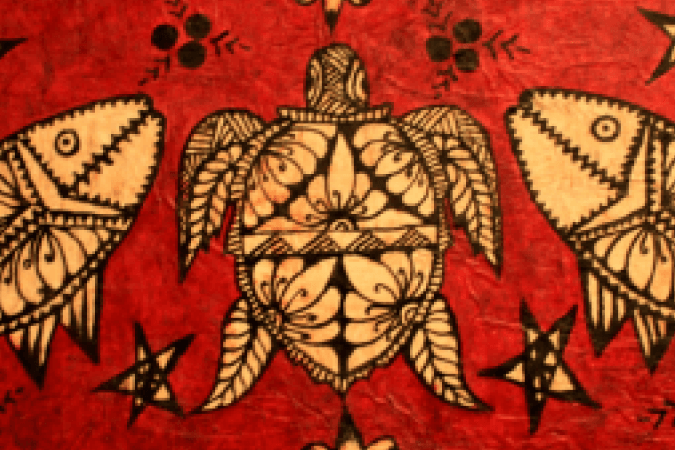Tutor:
Come in, Helen, what can I do for you?
Helen:
Well, I'm doing research for the anthropology project. And I was hoping to ask some help for a few details
Tutor:
Sure. I remember you opted Pacific tapa cloth as the topic, didn't you? What do you figure out so far?
Helen:
Well, I was going to introduce my project by stating that tapa cloth is fibre made from bark, just the out layer of the trees, which particularly universal among the Pacific Islands, but not exclusive to them.
Helen:
Actually, people in other parts of the world have also produced high-quality cloth from bark. But what set pacific tapa apart is the incredible variety role it's played in this region.
Tutor:
Nice! So what about raw materials that used in the production?
Helen:
Well, tapa cloth is made from many species of tree. In the Pacific, the paper mulberry tree is most common, but it doesn't thrive in all conditions.
Helen:
In fact, it wasn't discovered in the islands at first, but was carried in canoes by the first migrants. Tapa is also made from the breadfruit tree, which is a more convenient way, because its fruit is the staple food. The paper mulberry tree is only grown for tapa making mill.
Tutor:
Yes, that's right. Then how about the Maori people here in New Zealand?
Helen:
But at present the Maori don't produce tapa
Tutor:
Yeah, but I suggest you should take it into account. We know that when Maori migrate here from other pacific islands, they were ready to produce tapa because they took the paper mulberry tree with them.
Helen:
The thing was after they'd been in New Zealand a bit, they found the flax plant is superior to tapa, because it makes stronger fabric. By the time Europeans arrived in the 18th century, Mao were producing all their fabric from flax rather than the tapa and had been for some time.
Tutor:
OK. So in terms of the production process itself, first the inner bark is beaten with wooden hammer to soften the fibres; then the various pieces are glued together using adhesive paste made from the aloe root tuber, which is the only way to fabricate large pieces of cloth because bark strings are too fine to be woven together and stitch isn't strong enough.
Tutor:
So now you should do more research on the details about different countries.
Helen:
Where should I go into now?
Tutor:
Well, I think Samoa is the typical place known for its Seaple, which is hand-painted with representations of the ancestors.
Tutor:
Till now, at the most profound events in lives, such as births, funerals, weddings and the investiture of chief, some are with Seaple ropes to add significance and eating to the ceremony.
Helen:
OK. Then I can talk about Tonga. It seems to me that the great innovation in Tonga has been developing a simple coarse cloth, which is quick and easy to produce.
Helen:
This is suitable for all sorts of daily functions around the house like bed covers, nets and curtains.
Tutor:
Good point. Now what about Cook Islands tapa?
Helen:
Well, the Sweallier is of poor quality; consequently, the bread fruit tree is often used.
Helen:
One type of thick cloth, called Tikoda, was wrapped around the poles and used to make the entrances to places of worship, and therefore, was highly regarded in local culture.
Tutor:
You might mention Fiji as well, which is interesting, because tapa was actually used as currency there. Fijians used to sail between the islands and exchange tapa for other commodities like canoes or pigs.
Helen:
I know that in Tahiti, the tapa cloth is regarded differently, because the patterns are in colour, which is considered more valuable than the usual patterns.
Tutor:
You are right about the Tahitians using coloured pigments, but they aren't more valuable. The colours are only decoration.
Tutor:
People enjoy wearing bright robes especially for dancing and competitive games and do it just for fun.
Helen:
Oh, I'll take a note of it. Well, the last place I was going to mention was Tikopia. Even today it's a common place to see wearing clothes made of tapa cloth.
Helen:
And on many of the other islands, the tapa only come out on special occasions. But here you see people working in the gardens wearing tapa.
Tutor:
Sound promising, Helen. I'll look forward to the presentation of your project.
 Sau khi nghe " What do you figure out so far? "(tìm hiểu được gì -> sắp đưa thông tin về Pacific tapa cloth)
Sau khi nghe " What do you figure out so far? "(tìm hiểu được gì -> sắp đưa thông tin về Pacific tapa cloth) Sau đó Helen nói tiếp " Actually, people in other parts of the world have also produced high-quality cloth from bark."
Sau đó Helen nói tiếp " Actually, people in other parts of the world have also produced high-quality cloth from bark."
 Sau đó nghe tiếp "But what set pacific tapa apart is the incredible variety role it's played in this region."
Sau đó nghe tiếp "But what set pacific tapa apart is the incredible variety role it's played in this region." 

